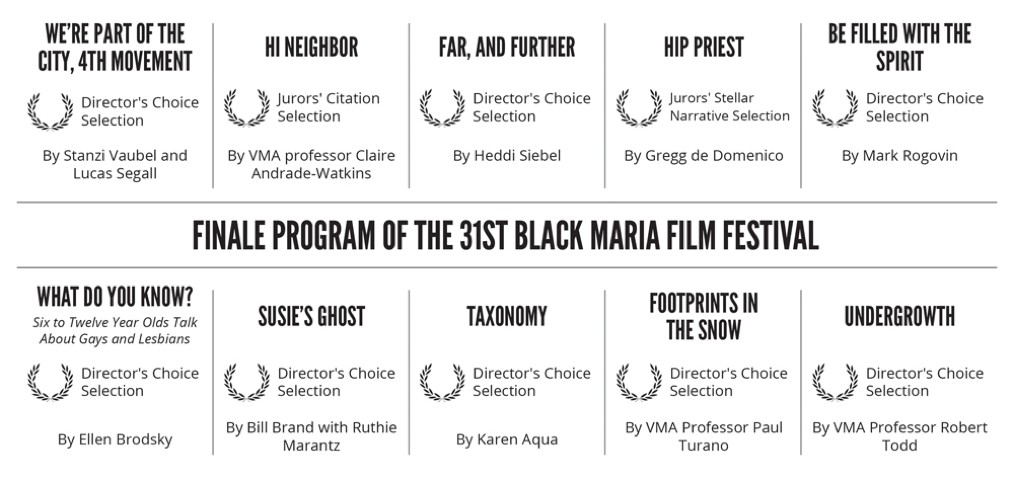http://www.berkeleybeacon.com/arts/2012/11/15/the-black-maria-film-festival-comes-to-emerson
The Black Maria Film Festival comes to Emerson
by Armando Vazquez / Beacon Correspondent • November 15, 2012

The Black Maria Film Festival spotlighted a myriad of genres.
·
·
·
Film students and enthusiasts might be familiar with the Black Maria, the first production studio, which was constructed by Thomas Edison. Many of the films shot were magic shows, vaudeville performances, and boxing matches.
The Black Maria Film Festival, named after Edison’s studio, celebrated its 31st season on Thursday, Nov. 8 in Emerson’s Bright Family Screening Room — though top hats and bunnies were traded in for opinions on homosexuality and social hierarchy.
The Screening Room was one of 60 host sites across the country showing the festival. Other venues included the National Gallery of Art in Washington, D.C.; the Virginia Museum of Fine Arts in Richmond; The Edison-Ford Winter Estates and Museum in Ft. Myers, Fla; and The New York Public Library, among others.
As Festival Director and Founder John Columbus gave his final words, the lights dimmed and the audience watched 10 different films. The festival included three works by Boston natives and three additional productions by Emerson faculty.
“[The films] were all very fruitful and thoughtful and gave you an opportunity to interact with them. When I heard there was a narrative, I assumed it was a very straight narrative and it wasn’t at all. As [John Columbus] said, they were very much like poems,” said Ana Feder, Events and internship manager for the visual and media arts department.
Capturing the chaotic and emotionally charged war between the upper and lower class, We’re Part of the City, 4th Movement, a film by Stanzi Vaubel and Lucas Segall is based around the Occupy Wall Street movement in New York City. The bedlam of the movement is represented through an ensemble of video footage and an intricate work of sound mixing.
What Do You Know? Six to Twelve Year Olds Talk About Gays and Lesbians by Ellen Brodsky, was an emotionally charged film that presented young children’s opinions on gays and lesbians.
“I want them to see [that] when adults ask questions and stay very, very quiet, children can tell us a lot.” said Brodsky. “They tell us a lot about what they think about gays and lesbians and what they hear at school and what they want their teachers to do.”
Far and Further, by Heddi Siebel is a unique take on Polar explorers of the early 20th century. The film approaches its narrative in the form of a visual metaphor through a juxtaposition of early exploration footage along with more contemporary visuals, like shots of the snow and the sea, in an effort to explore the impact they had in science and our view of the world.
Susie’s Ghost by Ruthie Marantz also takes an experimental approach — but this time at a much more personal instance in the artist’s life. Marantz explained that this piece is in reference to her deceased older sister who died. The film focuses on the image of Susie walking through the back alleys of New York, though, to the audience, the sense of whether she’s coming or going is not answered, creating the feeling of loss that people face after the death of a loved one.
Undergrowth by Emerson visual and media arts professor Robert Todd, is a fascinating juxtaposition of two separate works, creating an eerie and haunting view between predator, in the form of an owl, and prey, in the form of slow — moving shots through the ground.
“Undergrowth is a puzzle of perception and point of view about how we absorb point of view as viewers,” said Todd.
Last in the lineup was Hip Priest by Gregg de Domenico. The gritty black and white film centers on a street savvy priest who takes a different approach to his ministerial duties in Brooklyn, N.Y. This 27-minute short film, evoking the same abrasive New York City edge as Martin Scorsese’s Taxi Driver, beautifully highlights the contradiction of character and profession, making for a fascinating piece.
“I’d say we had 80 to a 100 people,” said Feder. “It was a good turnout, and more than half the audience was Emerson.”
